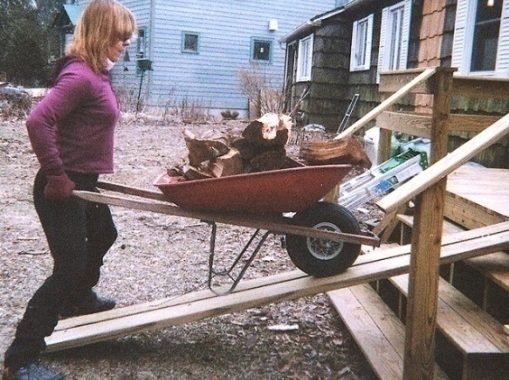Wheelbarrow (Download)
Wheelbarrow Safety http://www.google.com/images 1 Definition A wheelbarrow is a small hand-propelled vehicle, usually with just one wheel (some have two wheels ), designed to be pushed and guided by a single person using two handles to the rear. Source: http://en.wikipedia.org/wiki/Wheelbarrow http://www.google.com/images 2 Design Concept Wheelbarrows are designed to distribute the weight of the load between the wheel and the operator, enabling the convenient carriage of heavier and bulkier loads than would be possible if the weight was carried entirely by the operator http://www.google.com/images Source: http://en.wikipedia.org/wiki/Wheelbarrow 3 History The wheelbarrow may have been invented in Ancient Greece in the early 400’s B.C. It was primarily used on construction sites It reappeared in Medieval Europe sometime between 1170 and 1250 It was used for building construction, mining operations, and agriculture Source: http://en.wikipedia.org/wiki/Wheelbarrow 4 History China also had a version of the wheelbarrow. The first descriptions came from the 2 nd century Han Dynasty tomb murals and brick tomb reliefs It was used for transporting military supplies Source: http://en.wikipedia.org/wiki/Wheelbarrow 5 History The Chinese wheelbarrow had a wheel in the center of the barrow whereas the European wheelbarrow had a front-mounted wheel similar to modern wheelbarrows http://www.google.com/images Source: http://en.wikipedia.org/wiki/Wheelbarrow 6 Design Over Time The wheelbarrow has evolved from using rocks as wheels, to wood as wheels, to modern designs in which rubber tires are used Some wheelbarrows are equipped with two wheels to allow for greater support http://www.google.com/images Source: http://en.wikipedia.org/wiki/Wheelbarrow 7 Safety Concerns Tip-overs Falls Blisters Splinters http://www.google.com/images 8 Potential Hazards Unguarded edges Narrow walkways Uneven ground Obstacles Inclines http://www.google.com/images 9 Statistics on Fatalities Most wheelbarrow fatalities are due to falls or struck-by accidents The falls occurred primarily on roofing jobs where wheelbarrows were used with inappropriate guardrail systems or unguarded openings The struck by accidents were caused by loss of control of another piece of equipment that subsequently killed the worker operating a wheelbarrow Source: Extracted from OSHA Accident Investigation Data 1990-2009 10 Fatality Statistics (11 Cases) Source: Extracted from OSHA Accident Investigation Data 1990-2009 11 Case #1 A worker was using a wheelbarrow to dump debris from a reroofing job into a trash chute that was hung from a parapet wall. The chute was accessed by a ramp which led to the top of the parapet wall and the chute opening. There was a 2 inch square bumper at the end of the ramp (smaller than required by OSHA – 4 inches thick and 6 inches high) and there was no guardrail across the chute opening. While dumping a load of debris the worker was killed when he fell into the chute, landing 50 feet below in a dumpster. Source: Extracted from OSHA Accident Investigation Data 1990-2009 12 Case #2 Three workers were removing roofing on a 5:12 pitch roof that had a 3 ft flat surface around the perimeter. One worker had loaded a wheelbarrow with roofing debris and was walking backward with the wheelbarrow along the 3 ft flat roof perimeter. He either tripped, lost his balance, or lost his perspective of where he was. He fell from the roof’s edge and was killed by the 30-foot fall. The roof had no catch platform nor were the workers using safety belts with lifelines. Source: Extracted from OSHA Accident Investigation Data 1990-2009 13 Case #3 A worker was removing the bricks from a low sloped metal roof with a wheelbarrow. She had made a few trips to the leading edge to dump bricks over the side. The wheelbarrow path led past an unguarded skylight. After dumping the bricks over the side, the worker turned around, grabbed the wheelbarrow with her arms behind her back and proceeded up the roof to the work area. While pulling the wheelbarrow up the roof, she stepped through an unguarded skylight and fell 23 feet to her death. Source: Extracted from OSHA Accident Investigation Data 1990-2009 14 Case #4 A worker was delivering concrete mortar with a wheelbarrow to a wooden platform, which was covering a stairwell shaft opening. The wooden platform gave way and the employee fell 32 feet to his death. Source: Extracted from OSHA Accident Investigation Data 1990-2009 15 Case #5 A concrete truck was making a delivery. The driver observed a worker lift the wheelbarrow handles and take two steps toward a nearby testing area. The driver put the truck in reverse and began to back toward the pour location. Apparently, the laborer had difficulty balancing and moving the full wheelbarrow. The truck had backed up about15 ft when he ran over the worker who died immediately. Source: Extracted from OSHA Accident Investigation Data 1990-2009 16 OSHA Regulations OSHA Standard – 1926.852(f) Where the material is dumped from mechanical equipment or wheelbarrows, a securely attached toe board or bumper, not less than 4 inches thick and 6 inches high, shall be provided at each chute opening http://www.google.com/images 17 Personal Protective Equipment Main Heavy-duty gloves Steel-toe boots Additional Hard Hat Cover-all clothing Safety glasses Safety vest Back brace http://www.google.com/images 18 Best Practices Damage Check for damage to the frame and bucket Make sure the tires are fully inflated Loading Do not overfill the wheelbarrow Keep items from sticking out over the sides of the bucket Take into account the weight to strength ratio of the wheelbarrow to the worker Make sure that it is loaded evenly http://www.google.com/images Source: http://www.ehow.com/about_6396476_wheelbarrow-safety.html 19 Best Practices Lifting Firmly grip handles and lift with the knees, not the back Speed Do not move too quickly because, when heavily loaded, a wheelbarrow can have significant momentum and it is hard to stop abruptly Keep moving forward instead of starting and stopping http://www.google.com/images Source: http://www.ehow.com/about_6396476_wheelbarrow-safety.html 20 Best Practices Obstacles Define a clear pathway Look ahead to avoid obstacles by going around them Go over any obstacles at a right angle to avoid tipping the wheelbarrow http://www.google.com/images Source: http://www.ehow.com/about_6396476_wheelbarrow-safety.html 21 Best Practices Inclines Avoid inclines if possible going up, the wheelbarrow can roll back down and run over the worker. It is important to have adequate momentum so the wheelbarrow can be pushed all the way to the top of the incline without stopping going down, the wheelbarrow can pick up speed and get out of control http://www.google.com/images Source: http://www.ehow.com/about_6396476_wheelbarrow-safety.html 22 Think Safety Work Safely 23

